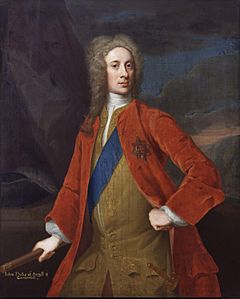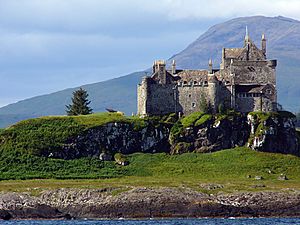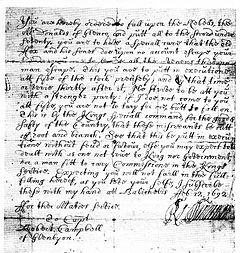Earl of Argyll's Regiment of Foot facts for kids
Quick facts for kids Argyll's Regiment of FootLord Lorne's Regiment (from April 1694) |
|
|---|---|
| Active | April 1689 - February 1697 |
| Allegiance | |
| Type | Infantry |
| Role | Line infantry |
| Garrison/HQ | Perth Fort William Brentford Diksmuide Damme |
| Engagements | Jacobite Rising 1689-92 Massacre of Glencoe Nine Years' War Storming of Dottignies Siege of Dixsmuide |
| Disbanded | February 1697 |
| Commanders | |
| Colonel | The Duke of Argyll to April 1694 Lord Lorne to February 1697 |
| Lt-Colonel | Duncan Campbell Robert Jackson Patrick Hume Robert Duncanson |
Argyll's Regiment of Foot was a Scottish army group. It was formed in April 1689. Their main job was to stop people in the Scottish Highlands who supported the old king, James VII. This was known as the Jacobite opposition.
In February 1692, the regiment was involved in a sad event called the Glencoe Massacre. Later that year, they moved to Brentford near London. By early 1693, they were sent to Flanders (part of modern-day Belgium). There, they fought in a big war called the Nine Years' War. In April 1694, the regiment changed its name to Lord Lorne's Regiment. It was officially ended, or disbanded, in February 1697.
Forming the Regiment
On April 19, 1689, the Earl of Argyll was given a special job. The Scottish Parliament asked him to create a regiment of 600 men. This number later grew to 800. It was the first official Highland regiment, not just a local group.
Back then, army regiments were often seen as the personal property of their leader, called a Colonel. Regiments would even change names if a new Colonel took over. They were also meant to be ended as soon as their job was done.
Being a Colonel or lieutenant colonel was often a job that could be bought or sold. People could even own several of these jobs at once. Sometimes, the person who owned the job didn't actually lead the soldiers in battle. They would have someone else, like a Lieutenant-Colonel, do the actual military work.
For example, Sir Duncan Campbell of Auchinbreck was the first Lieutenant-Colonel. He was from a family that traditionally held this role for the Earls of Argyll. Later, Robert Jackson and Patrick Hume took over. However, Major Robert Duncanson seemed to be in charge of the regiment's daily operations for many years.
Highland regiments often recruited men from local areas. Captains, who were usually landowners, would find 60 men from their own lands. Records from October 1691 show that most soldiers came from Argyllshire. Many had names linked to the Campbell clan.
Officers were paid for their service. However, they could also earn more money in other ways. For example, they might take deductions for equipment or food. In Highland regiments, it was common for clan members to serve. This meant there was often a difference between what the government paid and what soldiers actually received.
Service in Scotland: 1689-1692
In July 1689, the Argylls were still training and not yet at full strength. They were sent to protect Perth after a Jacobite victory at Killiecrankie. A year later, they moved to a new army base at Fort William. Their job was to help bring peace to the Highlands.
The regiment spent the next 18 months taking back or destroying Jacobite strongholds. These included Castle Stalker, Duart Castle, and Cairnburgh Castle.
During the winter of 1691-1692, the Argylls were surrounding Invergarry Castle. This was the main home of the MacDonald of Glengarry clan. In January 1692, two companies of the Argylls, led by Captain Robert Campbell of Glenlyon, arrived in Glencoe. They had orders to collect payments.
The MacDonalds of Glencoe accepted the soldiers' presence. The Argyll soldiers later said they didn't know about any other plans until the morning of February 13.
The Secretary of State for Scotland, Lord Stair, gave specific orders. Major Duncanson was to join Glenlyon's group. Together, they were to move through the glen, killing anyone they found. They were also to take property and burn houses.
On the evening of February 12, Duncanson sent his orders to Glenlyon. Captain Drummond, a senior officer, delivered them. Glenlyon was told to start at 5:00 AM the next day. Duncanson and another commander, Hamilton, arrived after the main events were over.
A report from 1695 stated that about 30 men died. Some were tied up before being shot. Modern estimates also suggest around 30 deaths. There is no strong proof that others died from being exposed to the cold.
A special Parliament group looked into the events in 1695. They focused on whether the orders had been followed too strictly. They did not question if the orders themselves were legal. No one involved was ever charged with a crime.
Service in England and Flanders: 1692-1697
In May 1692, there was a worry that the Jacobites might try to invade England. Because of this, the Argylls and other Scottish units were moved to England. They were based in Brentford.
The threat of invasion ended after the English and Dutch navies won battles at Barfleur and La Hogue. So, in early 1693, the Argylls were sent to Flanders. On July 9, the regiment attacked French forts at Dottignies in Belgium. They lost many soldiers, especially in the Grenadier company led by Captain Drummond.
In April 1694, the Earl of Argyll gave his job as Colonel to his oldest son, Lord Lorne. From then on, the regiment was known as Lord Lorne's Regiment.
In 1695, Colonel Hume was badly hurt at the Siege of Namur. This left Major Duncanson in charge. The regiment was part of the army protecting Diksmuide, an important place. The French army surrounded Diksmuide. The Allied commander, Ellenberg, gave up after only two days. But Duncanson refused to sign the surrender papers. Ellenberg was later punished, and Duncanson was promoted to Lieutenant-Colonel in August for his bravery.
Normally, soldiers who surrendered were allowed to leave freely. Lord Lorne's Regiment was released and spent the winter in Damme. By 1696, the war in the Netherlands was slowing down. The regiment mostly did guard duty around Nieuport and Bruges. Lord Lorne's Regiment was officially ended in February 1697. This happened just before the Treaty of Ryswick was signed in September 1697, which ended the Nine Years' War.
|





